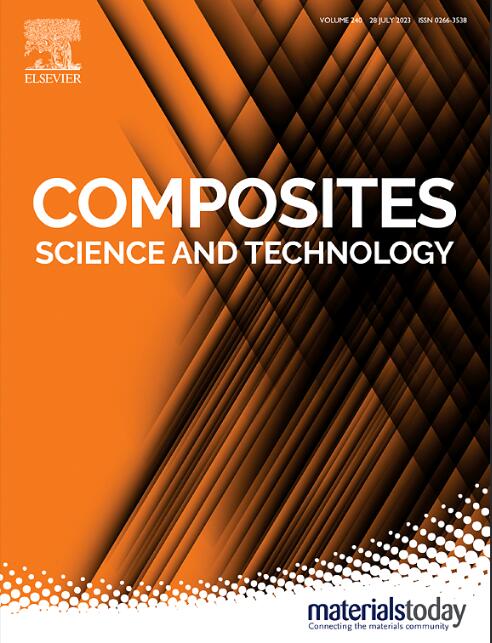用于电子器件热管理的液态金属基相变复合材料的宏观/微观协同导热性增强
IF 8.3
1区 材料科学
Q1 MATERIALS SCIENCE, COMPOSITES
引用次数: 0
摘要
液态金属(LM)由于其高导热性和相变吸热能力,在电子器件的热管理应用中显示出巨大的潜力。然而,当与有机柔性基板结合以创建复合材料时,高导热性的优点可以大大减少。为了解决这一挑战,本研究提出了一种宏观/微观协同增强导热系数的方法。通过用碳纳米管(CNT)涂覆LM颗粒,开发了模拟“神经元”结构的LM@CNT颗粒。LM@CNT与硅橡胶(SR)结合形成LM@CNT/SR,具有微级导热性能增强。LM@CNT在SR中的集成建立了一个导热网络,使得LM@CNT/SR的导热系数为1.37 W/m/K。受树干年轮的启发,垂直排列的石墨烯薄膜(VAGF)巧妙地嵌入复合材料中,以增强宏观上的导热性。结果表明,嵌入0.02 mm厚的VAGF可使导热系数提高8.8 W/m/K,而0.1 mm厚的VAGF可使导热系数提高24.7 W/m/K。LM@CNT/SR/VAGF的导热系数具有明显的各向异性。此外,LM@CNT/SR/VAGF表现出优异的稳定性,在近2000次温度循环后,导热系数的变化可以忽略不计。本研究中提出的生产高导热相变复合材料的方法采用简单且具有成本效益的工艺,为大规模生产此类复合材料提供了新的框架。这种方法在电子设备的热涌保护和热管理方面显示出巨大的应用潜力。本文章由计算机程序翻译,如有差异,请以英文原文为准。

Macro/micro synergistic thermal conductivity enhancement in liquid metal-based phase change composites for thermal management in electronic devices
Liquid metals (LM) demonstrate significant potential in thermal management applications for electronic devices due to their high thermal conductivity and phase change heat absorption capabilities. However, when combined with organic flexible substrates to create composite materials, the advantages of high thermal conductivity can be substantially diminished. To address this challenge, this study proposes a macro/micro synergistic thermal conductivity enhancement method. By coating LM particles with carbon nanotubes (CNT), the LM@CNT particles that mimics a "neuron" structure was developed. LM@CNT was combined with silicone rubber (SR) to form the LM@CNT/SR, which exhibits micro-level thermal conductivity enhancement. The integration of LM@CNT in SR establishes a thermal conduction network, resulting in a thermal conductivity of 1.37 W/m/K for the LM@CNT/SR. Inspired by the growth rings in tree trunks, vertically aligned graphene films (VAGF) are ingeniously embedded in the composite material to enhance thermal conductivity at the macro-level. The results show that embedding 0.02 mm thick VAGF can increase thermal conductivity by 8.8 W/m/K, while 0.1 mm thick VAGF can achieve an increase of 24.7 W/m/K. The thermal conductivity of LM@CNT/SR/VAGF has obvious anisotropy. Furthermore, the LM@CNT/SR/VAGF demonstrates excellent stability, with negligible changes in thermal conductivity after nearly 2000 temperature cycles. The methodology proposed in this study for producing high thermal conductivity phase change composite materials employs simple and cost-effective processes, offering a novel framework for the mass production of such composites. This approach shows substantial potential for applications in thermal surge protection and thermal management within electronic devices.
求助全文
通过发布文献求助,成功后即可免费获取论文全文。
去求助
来源期刊

Composites Science and Technology
工程技术-材料科学:复合
CiteScore
16.20
自引率
9.90%
发文量
611
审稿时长
33 days
期刊介绍:
Composites Science and Technology publishes refereed original articles on the fundamental and applied science of engineering composites. The focus of this journal is on polymeric matrix composites with reinforcements/fillers ranging from nano- to macro-scale. CSTE encourages manuscripts reporting unique, innovative contributions to the physics, chemistry, materials science and applied mechanics aspects of advanced composites.
Besides traditional fiber reinforced composites, novel composites with significant potential for engineering applications are encouraged.
 求助内容:
求助内容: 应助结果提醒方式:
应助结果提醒方式:


